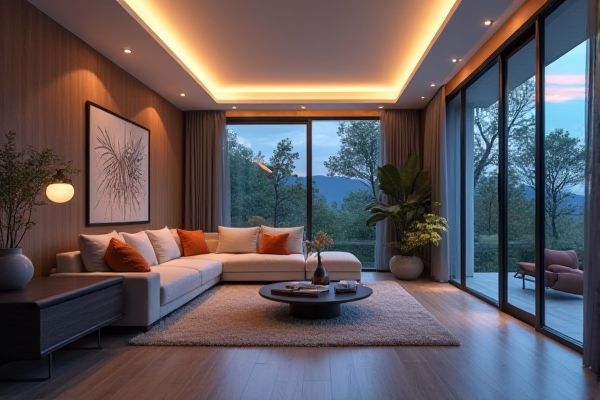
LED strip lights offer energy-efficient, flexible, and customizable lighting options with longer lifespan and lower heat emission compared to traditional fluorescent tube lights, which are bulkier and contain hazardous materials like mercury. Discover how choosing the right lighting can transform Your space by reading the rest of this article.
Table of Comparison
| Feature | LED Strip Lights | Fluorescent Tube Lights |
|---|---|---|
| Energy Efficiency | High (up to 90% energy savings) | Moderate (less efficient than LEDs) |
| Lifespan | 25,000 to 50,000 hours | 7,000 to 15,000 hours |
| Light Quality | Bright, adjustable color temperature, RGB options | Cool white, limited color temperature options |
| Durability | Robust, shock-resistant | Fragile, glass tubes |
| Environmental Impact | Contains no mercury, recyclable | Contains mercury, requires special disposal |
| Installation Flexibility | Flexible, cuttable, adhesive backing | Rigid, fixed length tubes |
| Initial Cost | Higher upfront cost | Lower upfront cost |
| Maintenance | Low, long replacement interval | Higher, frequent replacements and ballast issues |
Introduction to LED Strip Lights and Fluorescent Tube Lights
LED strip lights feature flexible circuit boards embedded with surface-mounted light-emitting diodes, offering versatile, energy-efficient illumination options with customizable color temperatures and brightness levels. Fluorescent tube lights utilize low-pressure mercury vapor gas to produce visible light through phosphor coatings, known for their widespread commercial use and long lifespan despite containing hazardous materials. Both lighting technologies serve distinct applications, with LED strips excelling in design flexibility and energy savings, while fluorescent tubes provide consistent, broad-area lighting in industrial and institutional environments.
Energy Efficiency Comparison
LED strip lights consume approximately 75% less energy compared to fluorescent tube lights, making them significantly more energy-efficient for both residential and commercial use. Their advanced semiconductor technology allows LEDs to convert more electricity into light rather than heat, reducing overall power consumption. Fluorescent tubes contain mercury and require frequent replacements due to shorter lifespans, further diminishing their energy efficiency over time.
Lifespan and Maintenance Requirements
LED strip lights offer a significantly longer lifespan, typically lasting up to 50,000 hours, compared to fluorescent tube lights which generally last around 7,000 to 15,000 hours. Maintenance requirements for LED strips are minimal due to their durability and resistance to breakage, whereas fluorescent tubes require frequent replacements and careful handling to avoid mercury exposure. Choosing LED strip lights can reduce your ongoing maintenance costs and the hassle of frequent bulb changes.
Light Quality and Color Options
LED strip lights offer superior light quality with high color rendering index (CRI) values above 90, ensuring vibrant and accurate color representation compared to fluorescent tube lights, which typically have CRIs around 70-80. LED strips provide a broad spectrum of customizable color temperatures from warm white (2700K) to daylight (6500K) and dynamic RGB options, allowing for versatile ambiance settings. Fluorescent tubes are limited mainly to fixed color temperatures and often produce flickering or inconsistent light, impacting visual comfort and color fidelity.
Installation Flexibility and Ease
LED strip lights offer superior installation flexibility with their adhesive backing and customizable lengths, allowing you to easily fit them into tight or irregular spaces. Fluorescent tube lights require fixed fixtures and more complex mounting, limiting placement options and making installation less convenient. Choosing LED strip lights enhances your lighting setup with quick, adaptable installation tailored to various environments.
Cost Analysis: Upfront and Long-Term
LED strip lights typically have a higher upfront cost compared to fluorescent tube lights, but their energy efficiency and longer lifespan result in significant long-term savings on electricity bills and replacement expenses. Fluorescent tubes may be cheaper initially, but frequent replacements and higher power consumption increase overall costs over time. Investing in LED strip lights can optimize your budget by reducing maintenance and operational costs significantly.
Environmental Impact and Safety
LED strip lights consume significantly less energy and have a longer lifespan compared to fluorescent tube lights, reducing waste and carbon footprint. Fluorescent tubes contain mercury, posing environmental and health risks if broken or improperly disposed of, whereas LEDs are mercury-free and safer to handle. Choosing LED strip lights enhances your safety and minimizes environmental harm due to their eco-friendly materials and energy efficiency.
Application Versatility
LED strip lights offer superior application versatility compared to fluorescent tube lights due to their flexible design and customizable length, allowing seamless integration into various environments such as under cabinets, shelves, and architectural accents. Fluorescent tubes are typically rigid and suited for larger, more industrial or office spaces requiring uniform lighting, but lack the adaptability of LEDs in tight or curved areas. Your choice depends on whether you need tailored, dynamic lighting solutions or traditional, broad-area illumination.
Design and Aesthetic Considerations
LED strip lights offer a sleek, flexible design that seamlessly integrates into various spaces, providing customizable color options and adjustable brightness for enhanced ambiance. Fluorescent tube lights typically have a rigid structure and emit a cooler, uniform light that may limit creative lighting designs. Your choice impacts the overall aesthetic, with LED strips better suited for modern, dynamic environments while fluorescent tubes fit traditional settings.
Choosing the Right Lighting Solution for Your Needs
LED strip lights offer energy efficiency, customizable color options, and longer lifespan compared to fluorescent tube lights, which consume more power and contain hazardous mercury. Your choice depends on factors such as installation flexibility, brightness requirements, and maintenance preferences, with LED strips excelling in modern, versatile applications. Fluorescent tubes remain suitable for consistent, broad lighting in commercial spaces but lack the adaptability and eco-friendliness of LED technology.
 homyna.com
homyna.com